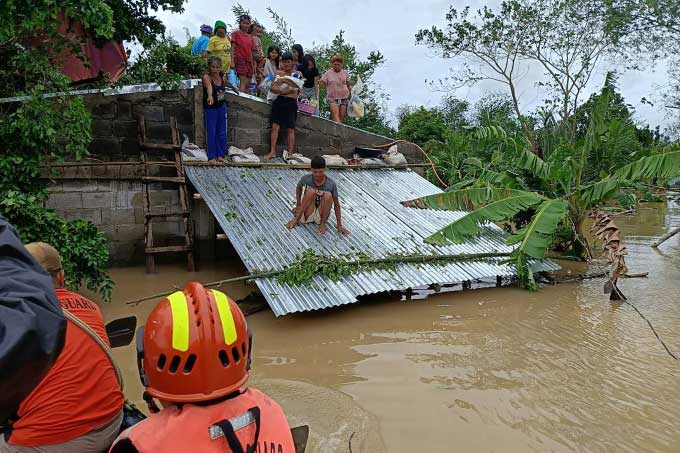Typhoon Tra Mi causes severe flooding in the Philippines, 14 people dead
Typhoon Tra Mi brought heavy rains and severe flooding in the northern Philippines, killing at least 14 people and forcing thousands to evacuate.
Torrential rains from Typhoon Tra Mi have turned streets into rivers, submerging homes and vehicles in the northern Philippines . Police said more than 47,500 people had been evacuated as the storm approached the country's main island of Luzon.
President Ferdinand Marcos today ordered rescue forces to be ready to respond, as the storm is expected to make landfall in the northeastern province of Isabela on the night of October 23 or early morning of October 24 with winds of 95 km/h.
"I'm afraid the worst is yet to come. Let us all be prepared. This kind of rainfall is unprecedented and we must monitor it closely ," President Marcos said.
Heavy rains caused by Typhoon Tra Mi caused severe flooding in Sorsogon province, Bicol region, Philippines on October 23. (Video: Philippine Red Cross).
The national weather agency Pagasa warned of strong winds, heavy rains and storm surges that could wreak havoc on coastal towns. Government offices and schools across the main island of Luzon were closed.
Tra Mi has brought heavy rains to the Bicol region, about 400 kilometers southeast of the capital Manila, causing floods to rise beyond expectations and complicating rescue efforts.
Media images showed water rising to the roofs of single-storey homes, with rescuers wading through chest-deep water to reach trapped residents.
"We have deployed police rescue teams, but they are having difficulty reaching some areas because the floodwaters are high and the currents are too strong ," said regional police spokeswoman Luisa Calubaquib.

Philippine Coast Guard members evacuate residents from flooded areas in Libon town, Albay province on October 23. (Photo: AFP).
At least 12 people died in Naga City, police chief Erwin Rebellon said. Two more deaths were reported in other parts of Bicol. Five fishermen are missing.
In the municipality of Bato, Camarines Sur province, streets were flooded, with houses and convenience stores only showing their roofs . "The situation is getting more dangerous. We are waiting for rescuers ," said Karen Tabagan, a resident of Bato.
In Naga, about 40 kilometers from Bato, half of the 600 villages were completely submerged by floods. Torrential rains also hit Albay province.
"In just 24 hours, our area received almost two months' worth of rain ," said Cedric Daep, head of the province's disaster response agency.

Houses are flooded up to their roofs in Bato, Camarines Sur province on October 23. (Photo: AFP).
After making landfall in the Philippines, Typhoon Tra Mi is expected to enter the East Sea with winds of level 9. Fueled by the sea, the storm may increase in strength each day, reaching level 12 (133 km/h) by the afternoon of October 26, with gusts of level 15, in the waters northeast of the Hoang Sa archipelago. Due to the impact of cold air, on October 27, the storm will shift southward, towards the central central coast, according to the National Center for Hydro-Meteorological Forecasting.
About 20 major storms hit the Philippines and surrounding waters each year, damaging homes, infrastructure and killing dozens. But recent research shows that storms are increasingly forming closer to shore, intensifying more quickly and lingering over land due to climate change.
- Philippines welcomes new storms
- Severe storms killed 17 Filipinos
- Hundreds of people died from typhoons and floods in the Philippines
- Philippines: Nearly 500 people were killed by typhoon Washi
- Video: Haiyan storm landed, causing flooding in China
- Philippines confirmed 1,774 people died of Typhoon Haiyan
- Thousands of people were isolated due to flooding
- 10,000 people may have died due to Typhoon Haiyan in the Philippines
- Philippines: 25 people died from storm Nock-ten
- Thousands of people were evacuated because of floods and landslides in the Philippines
- Photo: Super typhoon Yutu caused heavy damage when landing in the Philippines
- Super typhoon Nanmadol swept through the Philippines
 Is the magnetic North Pole shift dangerous to humanity?
Is the magnetic North Pole shift dangerous to humanity? Washington legalizes the recycling of human bodies into fertilizer
Washington legalizes the recycling of human bodies into fertilizer Lightning stone - the mysterious guest
Lightning stone - the mysterious guest Stunned by the mysterious sunset, strange appearance
Stunned by the mysterious sunset, strange appearance